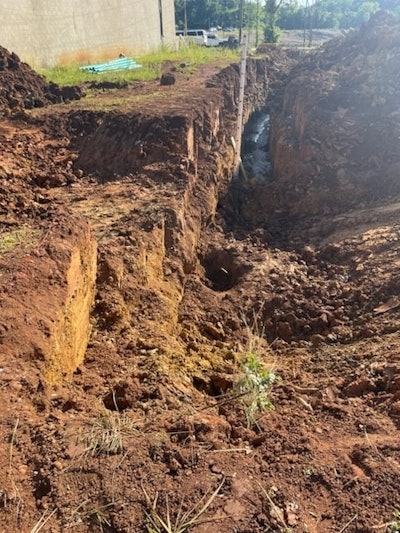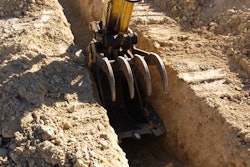
After 2022, the construction industry’s deadliest year since 2005 for trench collapses, at least 18 more workers have died in trenches, according to online safety records and media reports.
The deaths have been reported across the U.S., from Georgia to California, with the most common OSHA citation being failure to use proper cave-in protection – primarily, a trench box.
Some states had more than one fatal collapse during that time. Oklahoma and New York each had three deaths since 2022. Texas and California each had two fatalities.
(A brief description of each of the 18 fatalities is provided later in this story.)
Though deaths have continued, last year showed a steep drop in the number of fatal trench collapses in comparison to 2022, when 39 workers died in trenches.
In 2023, at least 14 workers died in trench collapses. That is more in line with 2021’s 15 deaths, as reported by OSHA.
Whether that’s a trend and 2022 was an outlier year, however, remains to be seen. Already in the first quarter of 2024, at least four workers have died in trenches. That death count could have been higher, however, if workers caught in cave-ins had not been rescued by emergency responders. Such rescues are rare because cave-ins can instantly bury workers under thousands of pounds of dirt. That makes it nearly impossible to reach them before they die by asphyxiation or being crushed.
The reduction in deaths from 2022 to 2023 has coincided with stepped up enforcement and public outreach by the U.S. Occupational Safety and Health Administration, as well as increased publicity efforts by trade associations.
“One hopes that all the attention paid to, especially the 2022 fatalities, sent a message to the industry that they need to pay more attention to this, and maybe we saw the effect of that in 2023. And hopefully, that'll continue into 2024,” says Jordan Barab, former OSHA deputy assistant secretary. “It’s always hard to tell with these things.”
However, the author of the “Confined Space” newsletter about work safety sees some issues that continue to lead to deaths that he and other safety advocates view as entirely preventable, if trench boxes were only used properly.
“Unfortunately,” Barab says, “a lot of these are relatively small construction companies that kind of escape the oversight of OSHA.”
He notes that the large construction projects, which have heavy oversight, mostly have trench boxes in use. But he and other safety advocates point out that most jobs where workers die in trenches are small ones in residential areas where it’s unlikely OSHA inspectors will be driving by or that people will notice a violation and call OSHA.
Barab mentions a conversation he had recently in his neighborhood where he spotted a dangerous trench with the town public works official on site. The official told him the town has a tight budget and has to take the lowest bidder, making it difficult to hire good contractors. Enforcing trench-safety rules, Barab said he was told, means losing the contractor on the job.
Barab says, too, that OSHA’s financial penalties aren’t much of a deterrence, as they tend to come after a fatality. He adds that because many of the small contractors aren’t members of trade associations that regularly promote safety, they remain unaware or unwilling.
“They're just kind of out there on their own,” Barab says. “They're trying to be the lowest-price contractor, so it's really hard to influence them.”
For that reason, Barab takes the stance that all trench-collapse deaths should result in “willful violations,” OSHA’s stiffest penalty. Such violations can also be considered for criminal prosecution, though they rarely are. Since they are misdemeanors, federal prosecutors don’t have much desire to pursue them. Local prosecutors have been filing charges for worker trench deaths in some cases, but not often.
But Barab believes that the threat of jail time would be a stronger deterrent.
“There is no excuse for any construction contractor not to know about the hazards of deep trenches and no feasible excuse for them not to actually protect their workers,” he says. “My feeling is every trench-collapse death should be a 'willful' and should have a much higher likelihood of landing the employer in jail than it is now.”
As to whether the industry is experiencing a trend toward fewer trench deaths, he remains skeptical:
“It'd be nice to think that the 2023 figures, and followed hopefully by a better year this year, signify a trend. It's a little too early to say. But maybe we'll see something better in future years, given the publicity behind some of these cases and OSHA’s outreach.”
But, he adds, “I tend not to be real optimistic about that, because you see these kinds of things go up and down and up and down.”
TRENCH DEATHS SINCE 2022
The following reports of worker deaths in trench collapses were gathered by media reports around the U.S. and searches of OSHA’s online records by Equipment World. The figures focus on cave-in fatalities and may not include all such deaths, which are sometimes not reported in the media or are handled in states that have occupational safety offices independent of the federal government.
2024 Fatalities
March 1 – Jacob A. Young, 21, was buried under 7 to 8 feet of soil in Dubuque, Iowa, while working on a new apartment complex. An apprentice with a local plumber and pipefitters union, he was working for Smith Dirt Wrx of Peosta. When emergency responders arrived, coworkers were trying to dig out Young, but with no success. His body was recovered over 3 hours later.
March 1 – Alberto Agustin Sandoval Cabello, 37, was part of a crew replacing a sewer line about 12 feet deep in a subdivision in Lewisville, Texas, when the trench collapsed. Coworkers tried to dig him out but were unsuccessful. Cabello, of Mexico, had been in the U.S. for about six months. His widow has filed a lawsuit seeking more than $1 million from Cabello’s employer, 2R Construction Services LLC of Wylie, Texas, as well as the City of Lewisville and others.
February 7 – A trench collapse killed a worker at a construction site near a mall in Shawnee, Oklahoma. The worker’s employer was Jerlow Construction Co. of Edmond. No further details have been released.
January 8 – Lauro Pacheco, 38, was buried under about 10 feet of dirt after entering an excavation to level a cesspool ring at a home in Stony Brook, New York. An employee of Darius Masonry Inc. of Copiague, he was pronounced dead on the scene.
2023 Fatalities
December 22 – A worker performing an emergency repair on a fire protection line at a hospital in New Canaan, Connecticut, was trapped in dirt 12 feet down. According to media reports, he was pulled out within 15 minutes. He died of internal injuries. He worked for Sound Construction Inc. of Easton. He was not identified publicly.
October 2 – Lorenzo Fuentes Cortes, 51, was working in a 5- to 7-foot-deep trench on a residential water line in Jackson, Wyoming. He worked for MD Nursery and Landscaping Inc. of Driggs, Idaho. The company was cited for inadequate cave-in, among other violations, and issued a penalty of $28,126.
September 28 – Javier Romero, 25, was in a trench over 8 feet deep replacing sewer parts and digging by hand when the unshored side next to the street collapsed in San Francisco, California. He was completely buried for over 2 hours before being extricated. He was employed by Darcy & Harty Construction Inc.
September 15 – An 18-year-old worker was in a 15-foot-deep trench near Fulshear, Texas, in a trench box that was not properly installed. The teen was pinned against the box’s wall by tons of dirt. Hurtado Construction Company of Richmond, Texas, was cited with a willful violation of inadequate cave-in protection and seven other violations related to the incident. The company has a long history of safety violations and was issued penalties of $257,811.
August 28 – Workers were in a trench at least 12 feet deep on a farm in Scott, Arkansas, to ensure elevation and that it was level when the trench collapsed. Soil hit one employee. Emergency personnel jumped in the trench to try to free the worker, but then a secondary collapse occurred. A second employee who had jumped into the trench to try to help was hit by the collapsing dirt and killed. The first employee and emergency personnel were trapped in the trench. The first employee was injured and taken to the hospital; four others were taken to the hospital for injuries. Kajacs Contractors Inc. of Poplar Bluff, Missouri, was issued a penalty of $65,333.
August 10 – Caleb Smith, 20, was found at the bottom of a 21-foot-deep excavation face-down in water with dirt on top of him in Georgia. He and another employee were installing a sewer line for Pyles Plumbing and Utility Contractors Inc. of Macon. The other worker managed to avoid complete submersion in the water but suffered fractures to his shoulder, pelvis and leg and was hospitalized. Pyles was issued proposed penalties of $308,000 for various violations, including improper use of the trench box.
July 20 – Frank Culotta, 50, was shoveling gravel in the bottom of an unprotected trench in South Knox County, Tennessee, that was about 10 feet deep when a side wall collapsed, covering him entirely and crushing him to death. Design One Building Systems Inc. of Knoxville was issued a penalty of $74,680.
June 7 – Two workers in Pacoima, California, were excavating and removing earth below the foundation of a retaining wall when the entire wall with the footings collapsed on top of one of the employees. Kna Construction Inc. of Walnut did not use any support system to stabilize the retaining wall and faces a penalty of $33,420.
May 18 – Wade King, 44, a project manager and workers were in a 10-foot-deep excavation in McAlester, Oklahoma, placing gravel around a new 24-inch sewer line. The trench had water in its bottom. Rocking L Dozer and Land Management LLC of Caney was cited for failure to provide cave-in protection and other violations and issued a penalty of $82,149.
April 25 – Tony Rice was an employee of the City of Eutaw, Alabama, working on a sewer project in a subdivision when the trench collapsed. Two other workers in the trench were able to escape. Water and sewer filled the trench. Rice’s body could not be extricated until nine hours later, while his family and coworkers looked on.
April 20 – Mark Holder, 59, was in a 6- to 7-foot-deep trench removing a clump of dirt from under a section of 4-inch coiled sleeved piping that was just laid down in Champion, New York. A large section of earth hit him in the back and forced him face first against the trench wall, trapping him in the trench, which was unprotected. His employer, Justin Taylor, owner of 13 Colonies Construction in Carthage, New York, and another employee removed Holder from the trench and called 911. Holder was pronounced dead at the hospital. Taylor faces a penalty of $21,431.
April 10 – Jose Valenzuela, 48, was in a 12-foot-deep trench installing a sewer tap and line installation for a home in Holdenville, Oklahoma, when soil caved in on him. Dawson Does It Plumbing Inc. faces a penalty of $12,000.
April 3 – Francisco Reyes, 41, and Fernando Lagunas Pereira, 28, were crushed by a concrete slab and killed while moving utility lines at Kennedy International Airport in New York. They were inside a trench shoveling dirt underneath the slab when it collapsed on them. Triumph Construction Corp. of Bronx faces a penalty of $59,133.
 NUCA
NUCA











